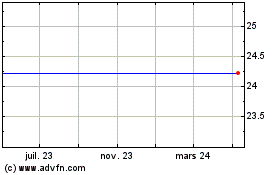TV Networks Creating Targeted-Ad Capabilities
13 Mai 2019 - 12:29PM
Dow Jones News
By Alexandra Bruell
Major TV programmers are starting to advance on the $2 billion
addressable-TV-ad business, which lets advertisers serve different
commercials to different households watching the same shows.
Network owners including Viacom Inc., CBS Corp. and Fox
Broadcasting Co. are having discussions with pay-TV providers to
start selling a small percentage of their national commercial time
as targeted ads . That would mean an automotive company could buy a
national ad and serve a minivan ad to pay-TV-subscriber households
where data suggests there are large families, for example, while
showing an ad for a basic passenger car to the rest of the country
watching the same show at the same time.
The efforts come as TV's decades-old model for ad sales based on
age and gender demographics is being disrupted by both ad-free
streaming services and digital giants like Google and Facebook.
Marketers have gotten used to being able to easily direct their
digital ads toward highly specific consumer targets based on a wide
variety of data.
The conversations are early and the amount of inventory in play
is small, according to people familiar with the matter. Many of the
networks are also having conversations with technology companies
that enable ad targeting for smart TVs.
Viacom, which owns cable networks such as MTV and Nickelodeon,
has deals with various pay-TV providers that distribute its
programming, the people said. The company has been testing
targeting with in-house promotional ads and will soon start making
it available to advertisers, they said.
CBS is exploring a similar capability, intending to make it
available to some advertisers over the next 12 months, according to
people familiar with the matter.
Fox is also looking to introduce targeted-ad capabilities for
its live programming, holding talks with pay-TV providers and
technology companies that enable ad targeting for smart TVs, said
an executive at the company. Fox parent Fox Corp. and Wall Street
Journal parent News Corp share common ownership.
AT&T Inc., meanwhile, has expressed ambitions to sell part
of its ad inventory on WarnerMedia networks, which include TNT and
CNN, on an addressable basis.
TV networks now sell most of their own commercial time, roughly
14 minutes per hour, to marketers whose ads then air in every home
that is tuned in. Pay-TV distributors such as Dish Network Corp. or
Comcast Corp. have the data and technology to simultaneously send
different commercials to various ZIP Codes and even households, a
capability they offer for the two minutes per hour they typically
control. The networks are exploring ways to provide that targeting
to their advertisers.
"We have advertisers that want it," said one executive at a TV
network. "We have constrained inventory we have to get more yield
from. We can only get a certain rate of change on demo buys each
year, and can charge a premium for addressable ads."
Programmers' addressable offerings aren't quite ready for prime
time, and most won't be offered in this year's upfront marketplace,
an annual event at which networks try to secure ad commitments for
the coming TV season.
Addressable-TV-ad spending surpassed $2 billion in 2018, and is
expected to exceed $2.5 billion in 2019, accounting for 3.7% of
total TV ad spending, according to a report from eMarketer. The
figure measures TV ads delivered on a home-by-home basis through
cable and satellite boxes, including video on demand. It excludes
connected TV, smart TV and over-the-top viewing.
"It's still a little unproven and there are definitely some
steps that need to be taken to scale the solution and execution of
it," said Kevin Arrix, senior vice president at Dish Network's Dish
Media. "I do expect that to accelerate in the next 12 to 24
months."
The early version of the addressable offering from programmers
will likely be available to advertisers that purchase an entire
national ad slot, and use the time to send different versions of
their ads to different households.
A targeted ad will likely be much more expensive than standard
ads that are seen by everyone, including customers an advertiser
isn't trying to reach.
The TV networks' project is a messy endeavor. Just as
advertisers now have to deal with many TV distributors if they want
to target commercials nationwide, the networks have to ink deals
with as many parties to assemble a national targeting
capability.
"It's a very small test at this point," said Mike Law, president
of Dentsu Aegis's media buying group Amplifi, of the TV
programmers' addressable efforts. Advertisers will work with
whomever is best at offering targeting in the greatest number of
markets, whether that is the programmers or an alternative such as
a joint effort from the cable operators, he said.
Write to Alexandra Bruell at alexandra.bruell@wsj.com
(END) Dow Jones Newswires
May 13, 2019 06:14 ET (10:14 GMT)
Copyright (c) 2019 Dow Jones & Company, Inc.
Viacom (NASDAQ:VIAB)
Graphique Historique de l'Action
De Mar 2024 à Avr 2024

Viacom (NASDAQ:VIAB)
Graphique Historique de l'Action
De Avr 2023 à Avr 2024
